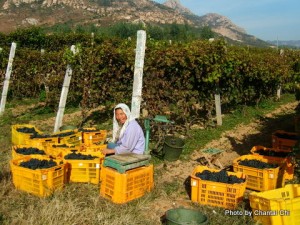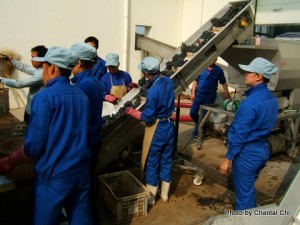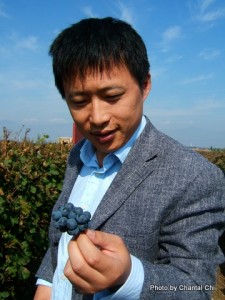By Chantal Chi
After spending a decade visiting the world’s wine regions, I decided this past year to see how the wine industry is progressing at home in China. Flying over China makes me realize that this country, with its diversity of climates and soils, is best considered as a continent. Given this, there should be an ideal “terroir” for wine in China, right?
My travels started in the northern province of Hebei, which surrounds the nation’s capital, Beijing. Smaller wineries have arisen here since bigger players settled down more than a decade ago. French-Chinese joint venture Dragon Seal led the way in 1987, but it lost its way in fine wine several years ago. “By marketing and branding, they think they can sell wines already,” said the company’s French winemaker, Jerome Sabate with little enthusiasm.
This is the major issue in the Chinese wine world: For most producers, wine is a product like any other and the goal is simply to have high returns. Fortunately, some people have a “philosophy” behind their wine making.
Going organic
Take Bolongbao winery, an organic producer in Hebei, just outside Beijing. Owner Zou Fu Lin decided to produce his own wine after tasting great wines while traveling in France. “After years of research, I finally found this ‘virgin” land,” he says of the vineyards. “It allowed me to do bio farming from the start.”
Hebei is also home to the organic viticulture of Bodega Langes, wholly-owned by the Austrian Swarovski family, which is best known for making crystal. The winery is fairly close to the coast and three hours by car from Beijing.
I arrived in early October. The villagers were picking the grapes in the vineyard, located at the foot of a mountain, to the strains of music (it plays in the cellar, too). Grain previously grew here, so Bodega Langes had to wait a few years before getting its bio certification in 2008. “Our owner wants to produce bio products according to his mother’s wish”, general manager Ren Jing explained.
Two organic wineries – great! I am more than pleased to see people who care about nature and about creating healthy products. But have they found ideal terroir for great wines?
Winery challenges
The answer was not clear. The vines inland need to be buried from November to March as protection from the severe cold and the threat of being dried out by the wind. The same goes for other wineries, including Sino-French Demonstration Vineyard and Grace Vineyard. These wineries also face issues common to other producers.
Sino-French started in 2001 as a joint venture between the French and Chinese governments, though the cooperation has since ended. I saw that the winery is suffering from a lack of care. Vice general manager Zhao De Sheng showed me the cellar and said they need new materials, such as barrels and bottles, and that their 2005 white is still in the tank. All their work, all those grapes, and all that wine – what a waste!
Grace Vineyard is in a much better position, with investment from wealthy overseas Chinese who want to show that China can produce great wines. I flew to Shanxi, the province just west of Hebei. Grace’s Australian winemaker Ken Murchison and Chilean winemaker Mr. Carrasco from Torres Chile – Torres distributes Grace’s wine in China – were supervising the key moments. Carrasco said the local team still had much to learn about wine-making.
Quality versus quantity
But the real challenge of making wine in China is relationships, from those with the village chiefs to those with the grape growers. Murchison, who joined Grace as winemaker at the end of 2005, said the vineyard usually deals with 450 grape-growers, but in 2008, which had a very abundant harvest, they dealt with 550 farmers who are used to doing things their own way.
“Give me great grapes and I will give you great wines,” goes a famous saying. But in China, getting great grapes is the hardest part. This is because the system generally dictates that the farmer who sells more grapes gets more money, which takes away a focus on quality. Farmers have no reason to do “green” harvest, to forgo irrigating the vines before harvest, or to reduce the yield, because these measures make no sense to those local farmers cause they are paid by weight.
Ambitions for greatness
Looking at the wine scene as a whole, perhaps one project symbolized that change is in the air. That project, in Shandong, is Chateau Junding, the premium winery opened about two years ago by the powerful COFCO group, which owns Great Wall, a top brand in terms of national production and sales. It is an ambitious project that is undertaken with goodwill. That such a big group sees quality wines as important and runs its winery with honor is, to me, a significant gesture in the Chinese wine industry.
However, this vineyard in Penglia, near the coast, also has its challenges. Damp summers and plentiful rainfall are not ideal for early maturing grape varieties. The humid weather causes diseases.
According to some wine professionals, there are potential “Eldorados” in northwest China, in Xinjiang and Ningxia, where the growing season features drier weather and plentiful sunshine. When I visited Loulan winery in Turpan, XinJiang, I found the sun hard to endure – it was 42 degrees Celsius at 11 in the morning! This also poses difficulties. Alain Leroux, a winemaker with Taillan China who is working as consultant for some wineries there, said “The grapes can get burned before getting a good polyphenalic maturity.”
The importance of attitude
So, where is THE ideal terroir in China?! A few months ago, I met Claude and Lydia Bourguignon, who specialize in analyzing soil in Burgundy and work with top wine producers, such as Domaine de la Romanée-Conti. I asked them if there would be any ideal terroir in China? “The climate and the soil are the source of good grapes, but a great wine is a combination of terroir, a suitable variety, and people!” they said.
Finding proper terroir in China seems to be a complicated issue. Viticulturists and winemakers here are still gaining experience and are not able to use as a guide the experience of their ancestors. They also face challenges such as investors who are focused on money-making, farmers who pursue quantity rather than quality when it comes to growing grapes, and administrators who can make it difficult to try to plant grape varieties that are suitable for the terroir but not the market.
How long will it take to overcome these challenges so that we can have great wines in China? I think the answer in China is not so much in the soil under our feet as it is in the attitude toward making wine.
(More posts by Chantal Chi)
Grape Wall has no sponsors of advertisers: if you find the content and projects like World Marselan Day worthwhile, please help cover the costs via PayPal, WeChat or Alipay.
Sign up for the free Grape Wall newsletter here. Follow Grape Wall on LinkedIn, Instagram, Facebook and Twitter. And contact Grape Wall via grapewallofchina (at) gmail.com.




to evalute just by one or two visite? especialy for chinese wine region, it’s no t fair.
in the old world you may say that, but, since there no much basical saduy on the terroir in china, if you can distiguish the wine region by one visit, you ‘ll be the best best best best super scientiste
Fascinating post! I’ve been wondering about the issue of terroir in China – it seems like there SHOULD be some ideal regions for vineyards, and yet, indigenous Chinese wines are still more miss than hit.
All of the knowledge and quality control issues aside – what areas do you think possess the greatest natural potential?
Excellent article, Chantal!